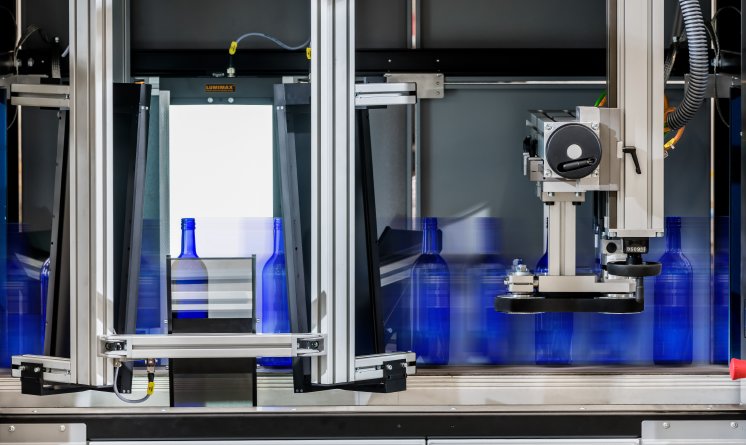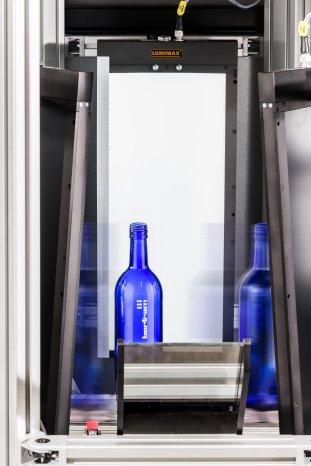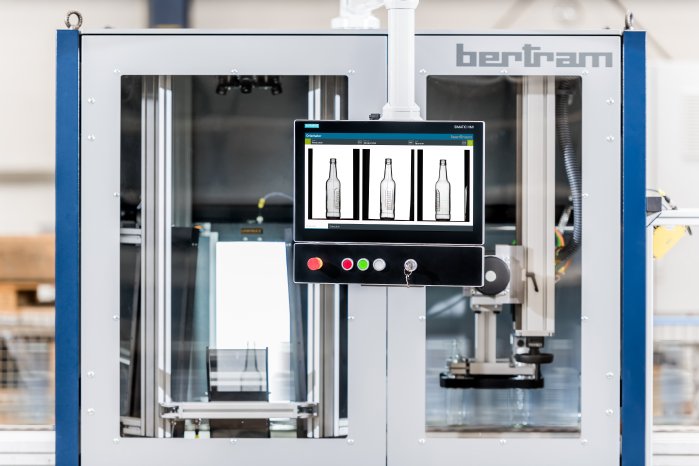Bertram Elektrotechnik, a company based in the German State of Lower Saxony, specialises in exactly this business segment. As an industrial material, glass has been a part of the company’s local Weser Uplands region since the Middle Ages. Part of Bertram Elektrotechnik’s business is developing innovative solutions for the alignment and ejection of container glass as part of process flows in glassworks or filling/packaging businesses. These solutions solve the problem of the careful alignment and feeding of bottles and jars required in a number of processes used in the glass industry and the sectors that it supplies to – such as food and beverages. There are many reasons for this, ranging from the exact positioning needed for precise labelling or the arrangements of packaged goods for palletisation to the uniform alignment of the packaged food products that line the shelves of food retailers. Another important aspect here is sidewall inspections, which are used to check for product defects, for example. The wide range of applications where glass packaging is used means they come in a great many shapes and sizes. As a result, the company needed to develop a product able to map the container glass into an Machine Vision system, regardless of its physical dimensions. The orientation of the different product variants needed to be detected quickly and reliably on the production line – with products then being repositioned as necessary.
The resulting ORIENTATOR developed by Bertram Elektrotechnik therefore combines a high-precision, highly dynamic servo-driven system with high-throughput industrial machine vision. The fully automatic alignment system combines three process steps into a single, compact machine: isolation, detection of the current alignment and reorientation into the correct position. The alignment unit, which has won the Lower Saxony Innovation Prize awarded by the Karl Moeller Foundation, can align up to 500 glass containers perfectly every minute. As a first step, the jars and bottles are fed into the machine by the conveyor belt. A separator is used to ensure the correct minimum spacing between the glass receptacles. A purpose-built guide system is used to synchronise the glass containers with the speed of the conveyor belt, so as to ensure that they do not fall over. A photoelectric barrier determines the exact position of the jars or bottles. The software then triggers image acquisition and the analysis of product alignment by the machine vision system. A set of three cameras is used to detect the exact position of the glass containers in a three-dimensional model. Predefined characteristics are then used to calculate the correction angles necessary. The software works out the parameters needed to perform a rotation by the alignment apparatus, which is then executed using a Siemens SIMOTION control unit. Based on image acquisition data, the glass containers are rotated into the required alignment using the shortest possible path. As it works, the alignment unit is also synchronised with the conveyor belt to avoid displacing the jars/bottles relative to conveyor belt movement.
Uniquely, the ORIENTATOR is designed to accommodate a very broad range of glass container types and is therefore able to handle even the most complex use cases. Whatever the various types of jars or bottles that need checking and realigning, however, the entire camera and lighting setup remains unchanged in most cases. This greatly simplifies system setup and retooling, since changes only need to be made to the software settings after a product changeover. Even less obvious features can also be learned by the system, enabling the ORIENTATOR to detect angles of rotation for many rounded glass products.
An innovative lighting design was required in order to successfully manage this challenge. LUMIMAX® LED Area Lighting solutions featuring LightGuide technology from iiM AG are the ideal choice for this kind of complex task. The Area Lighting Units here work with specially designed ‘light guides’, whereby light waves from High Power LEDs are fed into a laser-doped light guide plate before emission - diffused or collimated, just as required – over the entire light field. Thanks to this technology, the LUMIMAX® Lights achieve a homogeneity of more than 90 percent over the entire light field. Collimation ensures optimum levels of contrast in the images, which vastly increases measurement accuracy for the machine vision system. If exterior edges are rounded, diffuse backlight creates a partial shadow, with no binary transition from black to white in the object image. Instead, a grey gradient several pixels wide is produced, making it harder to identify the exact location of the edge. Collimated LUMIMAX® LightGuide Area Lighting is highly directional and the beam angle for the light generated is very low in comparison with the angle created by diffuse illumination. The light field intensity is also exceptionally homogeneous. The effect achieved is similar to that obtained by telecentric lighting. The directed rays of light are refracted directly by edges or embossed elements, for example, making these appear as sharply defined dark areas against a bright background. This kind of edge probing is therefore more exact than with diffuse backlight. For transparent and semi-transparent test objects in particular – such as glass packaging – this kind of collimation therefore offers clear advantages. Apart from glass container shape and alignment, the detection of embossments, engravings, scratches and inclusions in the test objects is also made easier. Products from the standard LUMIMAX® ranges were unsuitable because of the size required for the illuminated area. Accordingly, iiM AG developed a customer-specific lighting solution for Bertram Elektrotechnik that ensures its system is suitable for a very broad spectrum of glass packaging types.
Overall, the ORIENTATOR represents a significant set of improvements for quality control systems, while ensuring that downstream production steps can be designed to be easier and more efficient. As a result, palletising, filling, sealing and labelling systems can all work significantly faster. Since bottle and jar alignment is a fully automated process, fewer personnel are also required to operate these systems. With its small footprint, the ORIENTATOR is easy to integrate into existing conveyor systems. All in all, the smart deployment of machine vision systems achieves significant improvements to productivity.




